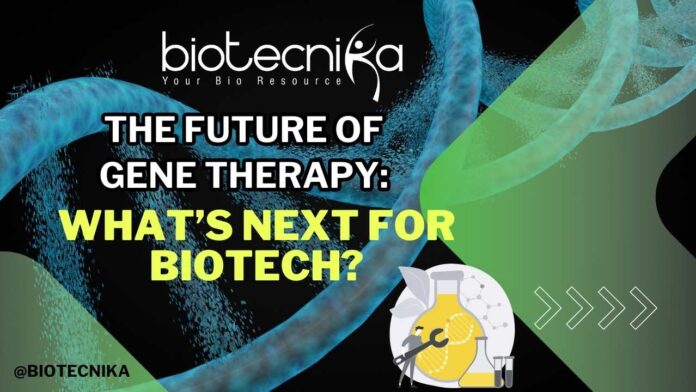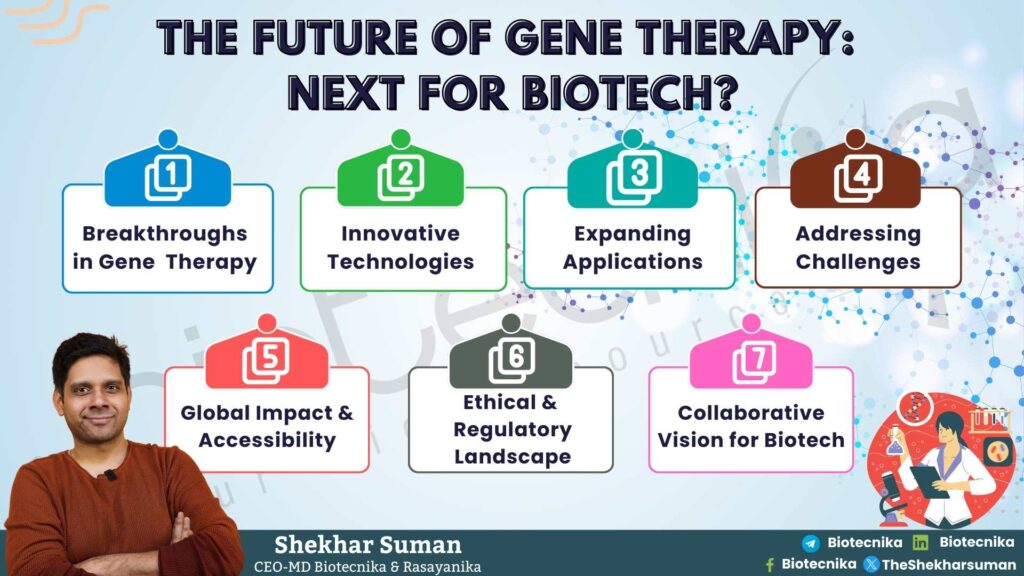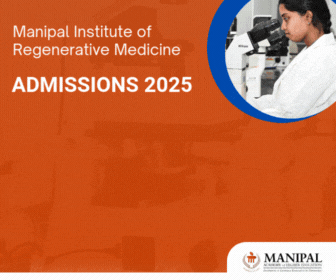The Future of Gene Therapy: What’s Next for Biotech?
“We used to think that our fate was in our stars, but now we know that, in large measure, our fate is in our genes” –James Watson.
Just one technical fault can derail the whole train. Likewise, a slight change in the base pair causes the same amount of damage to our bodies!
Genetic disorders arise because of faulty genes. Finding potential solutions for such conditions is crucial. This has become a novel research area in the biotech sector. Scientists are trying to find a cure for all diseases by establishing new innovative technology to help people live an everyday, healthy life.
Gene therapy thus has the potential for extreme in tervention from a therapeutic approach for genetic disorders as it works on the actual problems directly. Therefore, scientists unlock treatments that were once thought to be impossible to develop.
With advancements in tools such as CRISPR-Cas9, enhanced delivery systems, and promising outcomes from clinical trials, gene therapy is moving into a transformative era poised to redefine medical science.
The Future of Gene Therapy: What’s Next for Biotech?
Understanding Gene Therapy
Gene therapy refers to the modification of genetic information present in cells that are causing a diseased condition. Depending on the condition, gene therapy aims to replace faulty genes or inactive proteins that cause a particular condition. This can be achieved by introducing an entirely new gene to the cell.
There are two ways to achieve gene therapy:
- Ex vivo, where cells are modified outside the body and reintroduced or
- In vivo, where the treatment is delivered directly to the patient.
Gene therapy has been proven effective for both inherited and acquired diseases.
We can also observe the treatment approval for a few conditions, like Luxturna for inherited retinal dystrophy or Zolgensma for spinal muscular atrophy. These treatments have shown that gene therapy has moved from a hypothesis to a credible and working medical paradigm.
Recent Breakthroughs in Gene Therapy
1. Advances in CRISPR Technology
CRISPR technology took inspiration from nature. CRISPR-Cas9 technology has promised to revolutionize most inherited disorders through genome editing methods.
Researchers are also working on base editing, a refined version of CRISPR, to rectify single-point mutations with higher accuracy.
The acceleration of research on therapies for blood disorders has been brought about by the ex vivo editing of human hematopoietic stem cells (HSC) using CRISPR/Cas9.
The landmark achievement is the FDA approval of Casgevy, a CRISPR/Cas9-based therapy for severe sickle cell disease and β-thalassemia, representing the mainstream clinical application of this technology.
In the neuromuscular domain, CRISPR has revolutionized and advanced models of Duchenne muscular dystrophy (DMD). Moreover, these models can provide preclinical studies for genetic interventions that restore dystrophin production, and encouraging results have been shown during animal testing. However, efficient in vivo delivery, safety with high-dose viral vectors and immune-related risks remain significant hurdles to clinical translation.
2. Progress in Delivery Mechanisms
Effective gene delivery is essential for successful treatment. Recent innovations include:
- AAV Vectors: Adeno-associated virus vectors are effective due to their high in vivo transduction efficiency. These AAVs are being engineered for better safety and efficiency. Scientists are working on reducing immune responses to these vectors, a common hurdle in gene therapy.
Lipid Nanoparticles (LNPs): LNPs deliver CRISPR therapies and enhance intracellular delivery. It is mainly used in the treatment of angioedema. Preclinical studies showed significant reductions in inflammation markers.
Expansion of Applications
Unlike before, gene therapy was thought to help treat only rare genetic disorders. However, with the emergence of tools and techniques, this field is growing exponentially.
- Cancer: CAR-T cell therapy, a form of gene-modified immunotherapy, is being improved using CRISPR to target solid tumors. The focus is creating “off-the-shelf” allogeneic CAR-T cells to reduce costs and treatment delays.
- Neurological Disorders: Early trials are exploring gene therapy for Huntington’s disease, Parkinson’s disease, and ALS, aiming to repair or replace defective genes in the brain.
Challenges Facing Gene Therapy
While gene therapy holds great promise, it also faces significant challenges that must be addressed. A few of the challenges include;
- Expensive treatment procedures: Treatments like Zolgensma are priced at over $2 million per patient. These kinds of treatments are not accessible to the common man. Researchers are investigating modular manufacturing techniques and AI-driven optimization to reduce production costs.
- Immune Reactions: Delivery systems, such as viral vectors, often trigger immune responses that can reduce efficacy. To reduce these issues, scientists are combining AAV vectors with immunomodulatory nanoparticles.
- Longevity of the treatment: one of the significant hurdles of gene therapy includes ensuring the long-term expression of therapeutic genes without repeated treatments.
Techniques like epigenetic editing are being explored to provide sustained benefits.
The Future of Gene Therapy: What’s Next for Biotech?
Future Directions in Gene Therapy
- Therapies with Multiple Genes
As we know, disease has a multiplicity of genes. Therefore, scientists are now studying therapies that act on more than one gene simultaneously. This includes multiplexed CRISPR-system technology using multiple sites in the genome.
- Non-viral delivery methods
Researchers are developing alternative approaches to using viral vectors for gene therapy, such as electroporation and potentially promising nanocarriers. These methods significantly reduce immunogenicity and may allow better scalability.
3. Gene Therapy for Aging
Studies are investigating the use of gene therapy to address aging-related diseases. For example, therapies targeting telomere shortening and mitochondrial dysfunction are promising in preclinical models.
Gene therapy stands at the threshold of a new era in biotechnology. With advancements in CRISPR technologies, innovative delivery mechanisms, and a growing understanding of genetic disorders, the field is poised to revolutionize medicine. While challenges like cost and safety persist, ongoing research and global collaboration pave the way for a future where gene therapy is accessible.
4. The Role of Artificial Intelligence in Gene Therapy
AI is becoming revolutionary in gene therapy by innovating new delivery mechanisms-.
Vector Optimization: AI algorithms predict the finest viral vectors applicable for specific conditions to minimize trial and error approaches.
Patient Stratification: Machine learning promotes the identification of patients likely to benefit most from the therapy, conferring higher efficiency to the clinical trial process.
Data Analysis: AI would foster speedy analysis of clinical data by identifying trends to optimize treatment protocols.
5. Genome-Wide Editing and Epigenetic Therapies
- Genome-wide editing with CRISPR: The newest CRISPR-Cas systems, such as Cas12 and Cas13, are becoming more precise. And they are used for potentially wider disease treatment options.
- Epigenetic Editing: Techniques that target epigenetic marks, such as DNA methylation or histone modifications, are widely studied. They would provide a therapeutic impact permanently without changing the DNA sequence itself.
- Benefits: Indeed, such approaches would be reversible and less invasive than conventional gene editing.
Future Prospects: Integration of AI into gene therapy could lead to personalized treatments and reduced development timelines.
The Future of Gene Therapy: What’s Next for Biotech?
Top 5 scientists you should follow if you are interested in gene therapy
- Jennifer Doudna: Jennifer Doudna is one of the co-discoverers of this revolutionary CRISPR-Cas9 gene-editing technology. This technology helps revolutionize gene therapy. She enabled accurate editing of genetic materials, thereby making treatment of genetic disorders much cheaper and accessible to many patients.
- Emmanuelle Charpentier: Another very important scientist who won the Nobel Prize with Jennifer Doudna was Emmanuelle Charpentier. She also discovered CRISPR-Cas9. Her work continues to learn how to better utilize the CRISPR systems for disease-fighting. Her work explores bacterial immune systems and what can be learned about human gene therapies from such systems.
- Dr. Feng Zhang: Feng Zhang is a prominent scientist at the Broad Institute. He is known for taking a prominent role in developing CRISPR technology. His work covers CRISPR-Cas9 but also extends to other systems like CRISPR-Cas12 and CRISPR-Cas13, which are being used to develop therapies for genetic defects and disorders associated with RNA.
- Dr. Maria Grazia Roncarolo: Maria Grazia Roncarolo is one of the leaders in translating gene therapy into clinical practice. Her primary research is in the development of lentiviral vectors and stem cell-based gene therapies as treatment for rare and genetic diseases.
- Dr. Carl H. June: Carl June is the leader in cancer immunotherapy and gene therapy. His work focuses on engineering T-cells to fight cancer, a technique that has shown remarkable success in treating leukemia and lymphoma.
The journey ahead is exciting and sometimes uncertain, but we are on a train full of hope. Researchers are continuously working to bring in new solutions for various challenges. As the tools and techniques are advancing in biotech, curing diseases that were once thought to be incurable is gaining new hope.










































